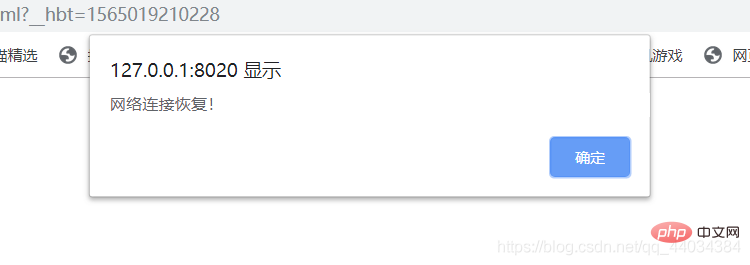How javascript detects the network
Javascript method to detect the network: 1. Detect the network through navigator; 2. Use "window.ononline" and "window.onoffline" events to monitor the browser's networking status; 3. Detect the network through ajax request.

The operating environment of this article: windows7 system, javascript version 1.8.5, DELL G3 computer
JavaScript determines the network status
1. Generally speaking, to judge the network status, the navigator provided by HTML5 is used to detect the network
<script type="text/javascript">
// 通过window.navigator.onLine 来检测网络是否可用
alert(window.navigator.onLine); // 返回的是一个bool值(true表示已连接,false表示未连接)
</script>
2. If you want to monitor the browser’s networking status, use window.ononline and window.onoffline events:
<script type="text/javascript">
window.addEventListener("offline",function(){alert("网络连接恢复");})
window.addEventListener("online",function(){alert("网络连接中断");})
</script>or:
<script type="text/javascript">
window.ononline=function(){alert("网络连接恢复");}
window.onoffline=function(){alert("网络连接中断");}
</script>
Note: This method belongs to the "listener" and will only be triggered the moment the network is connected/disconnected.
Summary: navigator.onLine and online, offline events are not omnipotent. On the PC side, only It can determine whether the wireless and network cables are connected, but it cannot determine whether there is a network or whether the Internet can be accessed.
A safer approach:
<script type="text/javascript">
var el = document.body;
if (el.addEventListener) {
window.addEventListener("online", function () {
alert("网络连接恢复");}, true);
window.addEventListener("offline", function () {
alert("网络连接中断");}, true);
}
else if (el.attachEvent) {
window.attachEvent("ononline", function () {
alert("网络连接恢复");});
window.attachEvent("onoffline", function () {
alert("网络连接中断");});
}
else {
window.ononline = function () {
alert("网络连接恢复");};
window.onoffline = function () {
alert("网络连接中断");};
}
</script>Note that to detect the ononline event, it must be bound to the window object
attachEvent - compatible with: IE7, IE8; not compatible with firefox, chrome, IE9, IE10, IE11, safari, opera
addEventListener - compatible with: firefox, chrome, IE, safari, opera; not compatible with IE7, IE8
Recommended study: "javascript Advanced Tutorial"
3. You can initiate an ajax request and determine the network connectivity based on the request result
<script type="text/javascript">
$.ajax({
url: 'https://sug.so.360.cn/suggest',
dataType:'jsonp',
success: function(result){
console.log('网络正常')
},
error: function(result){
console.log('网络异常')
}
});
</script>Of course, this method is not perfect, and it is not very practical. It cannot well distinguish whether the server is faulty or the user's network has problems, but this is indeed the most effective way.
The above is the detailed content of How javascript detects the network. For more information, please follow other related articles on the PHP Chinese website!

Hot AI Tools

Undresser.AI Undress
AI-powered app for creating realistic nude photos

AI Clothes Remover
Online AI tool for removing clothes from photos.

Undress AI Tool
Undress images for free

Clothoff.io
AI clothes remover

Video Face Swap
Swap faces in any video effortlessly with our completely free AI face swap tool!

Hot Article

Hot Tools

Notepad++7.3.1
Easy-to-use and free code editor

SublimeText3 Chinese version
Chinese version, very easy to use

Zend Studio 13.0.1
Powerful PHP integrated development environment

Dreamweaver CS6
Visual web development tools

SublimeText3 Mac version
God-level code editing software (SublimeText3)

Hot Topics
 1664
1664
 14
14
 1423
1423
 52
52
 1318
1318
 25
25
 1269
1269
 29
29
 1248
1248
 24
24
 How to implement an online speech recognition system using WebSocket and JavaScript
Dec 17, 2023 pm 02:54 PM
How to implement an online speech recognition system using WebSocket and JavaScript
Dec 17, 2023 pm 02:54 PM
How to use WebSocket and JavaScript to implement an online speech recognition system Introduction: With the continuous development of technology, speech recognition technology has become an important part of the field of artificial intelligence. The online speech recognition system based on WebSocket and JavaScript has the characteristics of low latency, real-time and cross-platform, and has become a widely used solution. This article will introduce how to use WebSocket and JavaScript to implement an online speech recognition system.
 WebSocket and JavaScript: key technologies for implementing real-time monitoring systems
Dec 17, 2023 pm 05:30 PM
WebSocket and JavaScript: key technologies for implementing real-time monitoring systems
Dec 17, 2023 pm 05:30 PM
WebSocket and JavaScript: Key technologies for realizing real-time monitoring systems Introduction: With the rapid development of Internet technology, real-time monitoring systems have been widely used in various fields. One of the key technologies to achieve real-time monitoring is the combination of WebSocket and JavaScript. This article will introduce the application of WebSocket and JavaScript in real-time monitoring systems, give code examples, and explain their implementation principles in detail. 1. WebSocket technology
 How to use JavaScript and WebSocket to implement a real-time online ordering system
Dec 17, 2023 pm 12:09 PM
How to use JavaScript and WebSocket to implement a real-time online ordering system
Dec 17, 2023 pm 12:09 PM
Introduction to how to use JavaScript and WebSocket to implement a real-time online ordering system: With the popularity of the Internet and the advancement of technology, more and more restaurants have begun to provide online ordering services. In order to implement a real-time online ordering system, we can use JavaScript and WebSocket technology. WebSocket is a full-duplex communication protocol based on the TCP protocol, which can realize real-time two-way communication between the client and the server. In the real-time online ordering system, when the user selects dishes and places an order
 How to implement an online reservation system using WebSocket and JavaScript
Dec 17, 2023 am 09:39 AM
How to implement an online reservation system using WebSocket and JavaScript
Dec 17, 2023 am 09:39 AM
How to use WebSocket and JavaScript to implement an online reservation system. In today's digital era, more and more businesses and services need to provide online reservation functions. It is crucial to implement an efficient and real-time online reservation system. This article will introduce how to use WebSocket and JavaScript to implement an online reservation system, and provide specific code examples. 1. What is WebSocket? WebSocket is a full-duplex method on a single TCP connection.
 JavaScript and WebSocket: Building an efficient real-time weather forecasting system
Dec 17, 2023 pm 05:13 PM
JavaScript and WebSocket: Building an efficient real-time weather forecasting system
Dec 17, 2023 pm 05:13 PM
JavaScript and WebSocket: Building an efficient real-time weather forecast system Introduction: Today, the accuracy of weather forecasts is of great significance to daily life and decision-making. As technology develops, we can provide more accurate and reliable weather forecasts by obtaining weather data in real time. In this article, we will learn how to use JavaScript and WebSocket technology to build an efficient real-time weather forecast system. This article will demonstrate the implementation process through specific code examples. We
 Simple JavaScript Tutorial: How to Get HTTP Status Code
Jan 05, 2024 pm 06:08 PM
Simple JavaScript Tutorial: How to Get HTTP Status Code
Jan 05, 2024 pm 06:08 PM
JavaScript tutorial: How to get HTTP status code, specific code examples are required. Preface: In web development, data interaction with the server is often involved. When communicating with the server, we often need to obtain the returned HTTP status code to determine whether the operation is successful, and perform corresponding processing based on different status codes. This article will teach you how to use JavaScript to obtain HTTP status codes and provide some practical code examples. Using XMLHttpRequest
 How to use insertBefore in javascript
Nov 24, 2023 am 11:56 AM
How to use insertBefore in javascript
Nov 24, 2023 am 11:56 AM
Usage: In JavaScript, the insertBefore() method is used to insert a new node in the DOM tree. This method requires two parameters: the new node to be inserted and the reference node (that is, the node where the new node will be inserted).
 JavaScript and WebSocket: Building an efficient real-time image processing system
Dec 17, 2023 am 08:41 AM
JavaScript and WebSocket: Building an efficient real-time image processing system
Dec 17, 2023 am 08:41 AM
JavaScript is a programming language widely used in web development, while WebSocket is a network protocol used for real-time communication. Combining the powerful functions of the two, we can create an efficient real-time image processing system. This article will introduce how to implement this system using JavaScript and WebSocket, and provide specific code examples. First, we need to clarify the requirements and goals of the real-time image processing system. Suppose we have a camera device that can collect real-time image data




